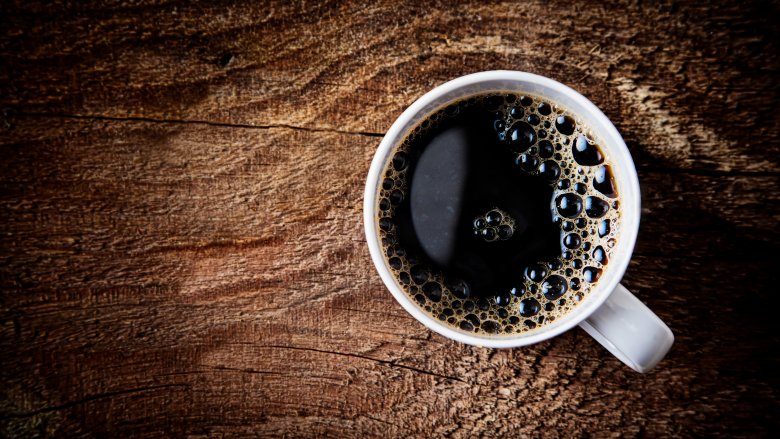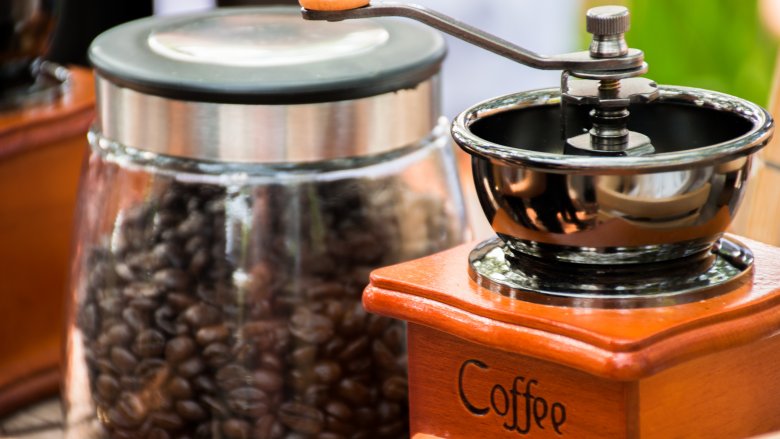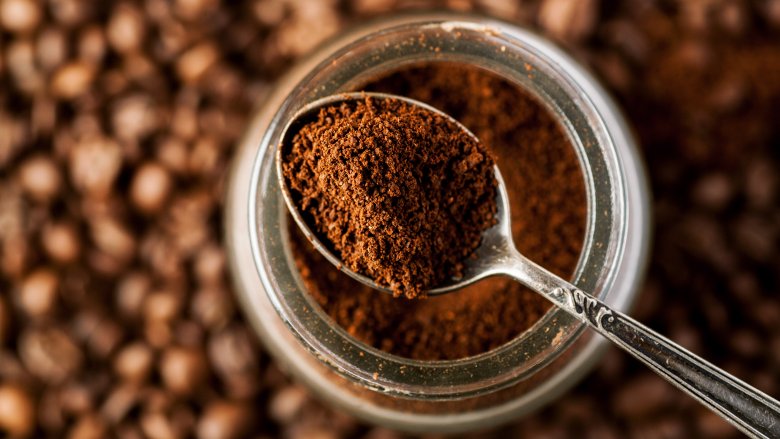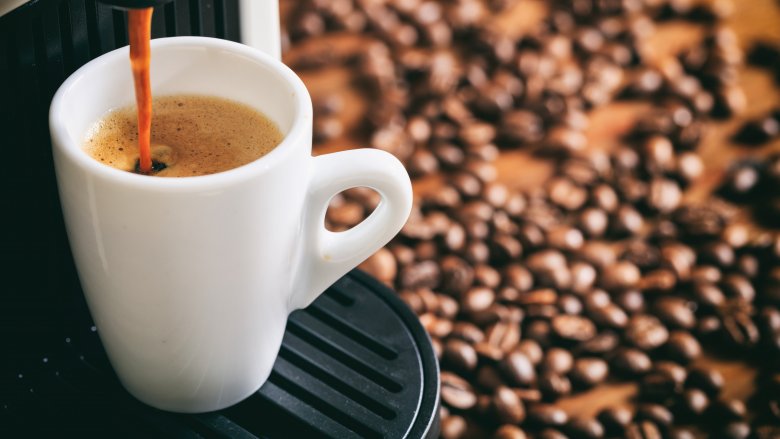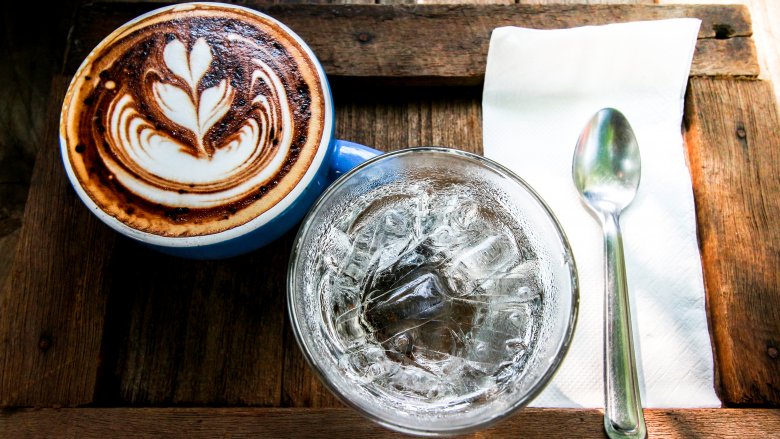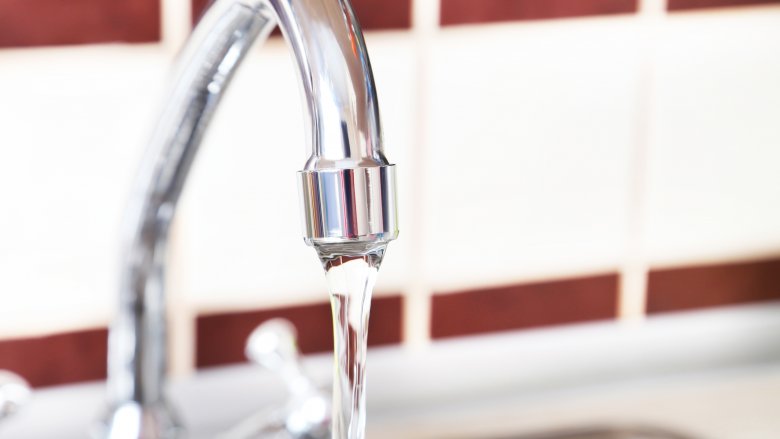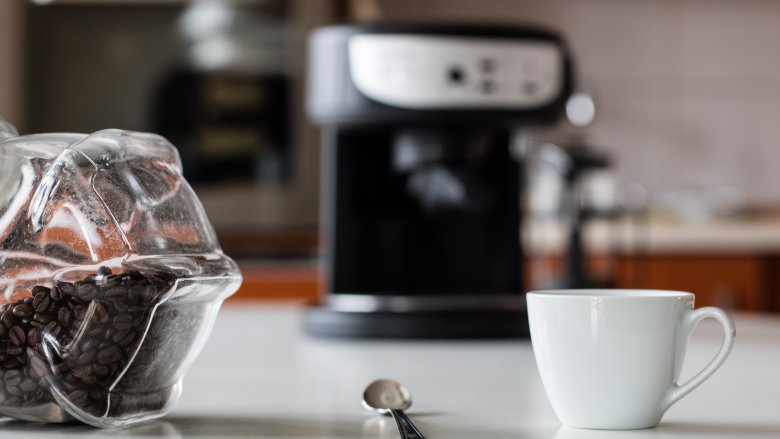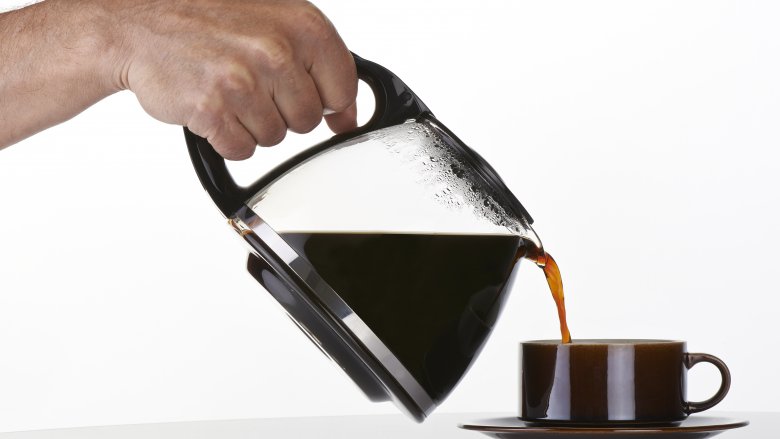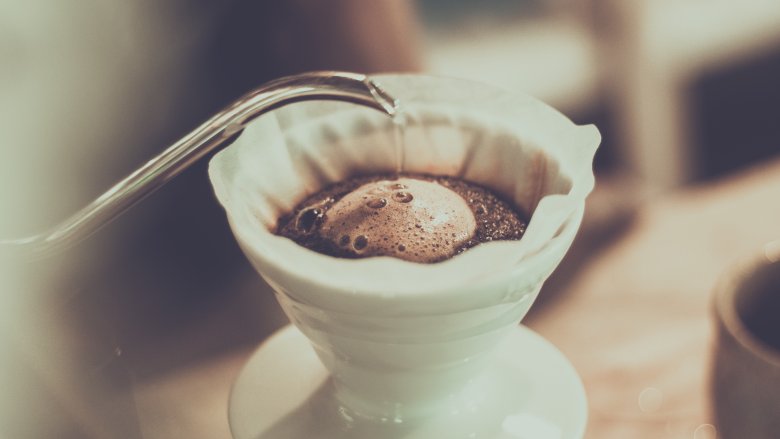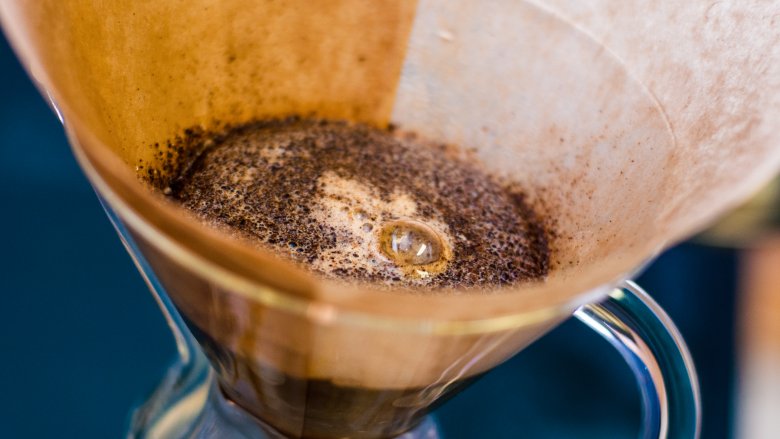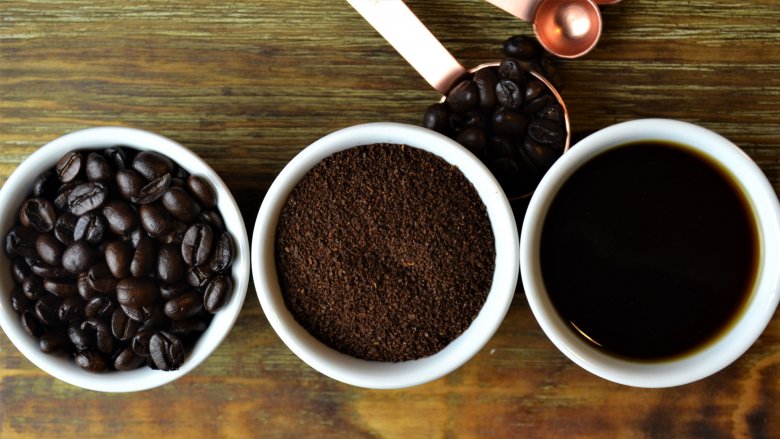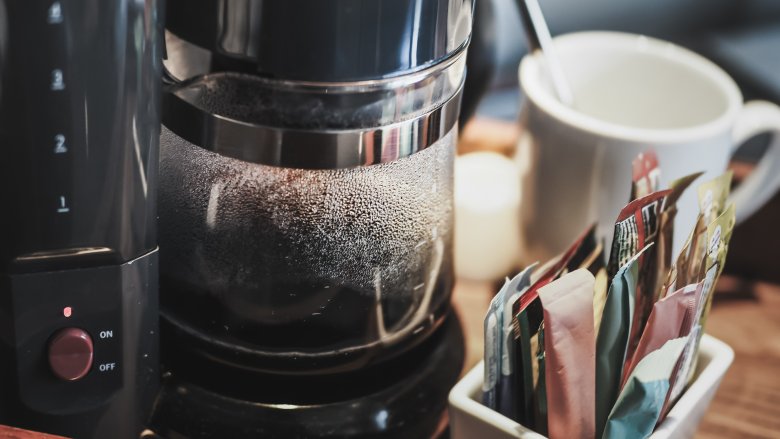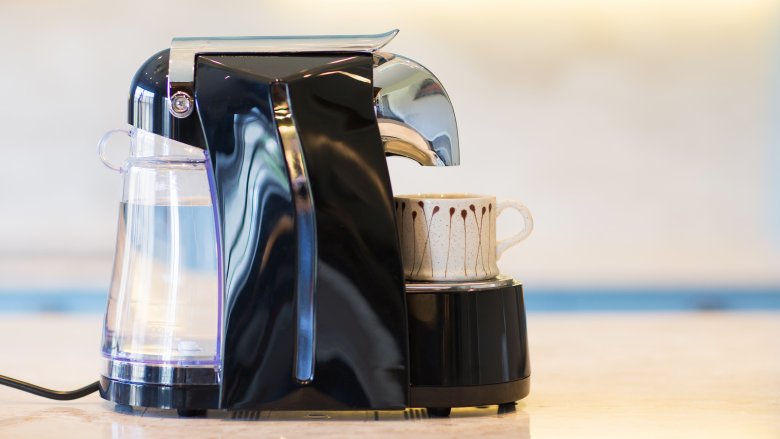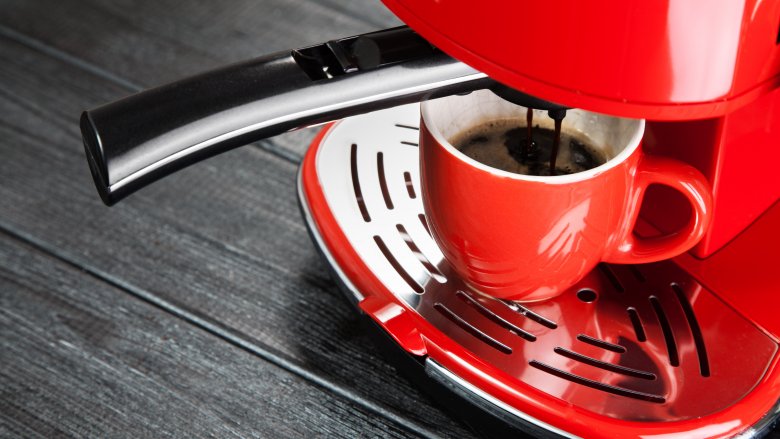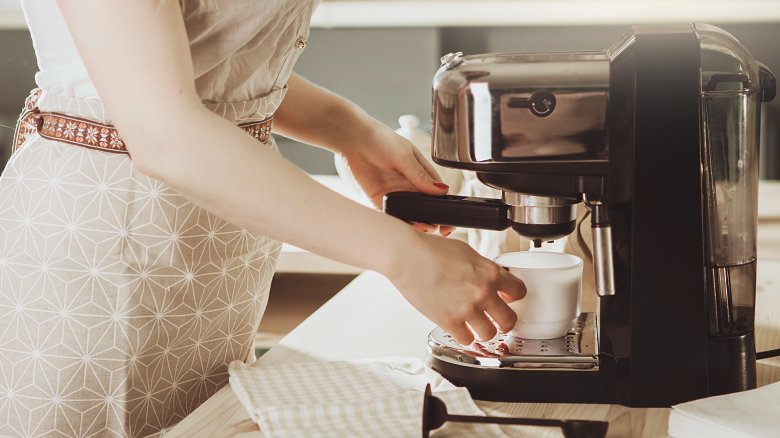You've Been Using Your Coffee Maker All Wrong
If you can't get started without your morning cup of coffee, you're not alone. According to the International Coffee Organization (via The Telegraph), Scandinavian countries lead the way when it comes to quantity. The average Finn goes through a whopping 26 pounds of coffee a year, and while the US comes in much lower than that — at number 26 — our average of eight pounds a year is still a lot of coffee to be pouring through your coffee maker.
So, that brings us to the important question: Are you getting the most out of your coffee maker, and all those pounds of coffee you're drinking every year? There are a ton of different ways you can make that morning, afternoon, or evening cup of joe, but chances are good your standard, countertop, drip coffee maker is still a favorite. You can set the timer and have it ready when you get up in the morning, after all, and you can't beat convenience. Let's talk about some of the things you're doing wrong, and how you can make it right to ultimately get a better cup of coffee.
Your grinder is nasty
A coffee maker is only going to make a cup that's as good as what you put in it, so let's start with the coffee itself. If you opt for whole bean, you undoubtedly have a grinder sitting right next to the coffee maker. When is the last time you cleaned it? Be honest, because it makes a difference.
Oils, residue, and bean bits can build up in a grinder and if it's not cleaned regularly, it'll give you an uneven, chunky grind. Pour that into your coffee maker and what makes it into your cup is going to be sub-par. Fortunately, it's super-easy to keep your grinder in good working order. Dallis Bros. Coffee barista and grinder engineer Philip Search (via Serious Eats) says you should always blow out all the debris with canned air or a vacuum. You'll also need to take your grinder apart to clean out the oily residue, and how often you need to do that depends on how much you use it. Finally, take a look at your burrs. They're going to wear, and you may need to replace them if you want a truly even grind (and again, how often depends on use).
You're using the wrong grind
If you just grind and go, you might be sabotaging your morning cup from the beginning, and here's why. Different grind sizes act differently in your coffee maker, and your perfect grind size depends on what sort of filter system your coffee maker has. It all has to do with how fast the filter allows the water to pass through, and the wrong combination can make your coffee too weak or too bitter.
There are a ton of coffee makers out there that have cone-shaped filters, and Lifehacker says the perfect grind setting for these filters is one that turns your beans into grounds that are about the consistency of granulated sugar, or a little finer. If your coffee maker has a permanent filter or one with a flat bottom, you're going to want a medium grind. If you're still in doubt, brew up a few pots with varying types of grounds and just see how much of a difference it really makes. If your coffee tastes too bitter, a coarser grind will probably help.
You're using the timer
We know, and we get it: the timer on your coffee maker lets you stumble out of bed and right to the coffee, and that's legit. But if you're more concerned about getting the best cup of coffee possible, you shouldn't use the timer — at least, not if you're taking the time to buy whole beans and grind your own.
Freshness makes a huge difference in the taste of your coffee, and according to CNET, it's such a big deal that you should aim for using your coffee somewhere between three days and a week after it was roasted. Once you open your bag of coffee — and especially when you grind those beans — they're hit by oxygen. That starts a process called oxidation, and that's what makes your coffee go stale.
So, if you're grinding your beans at night, putting them in your coffee maker, and setting the timer, you're giving your coffee all those hours to oxidize. That means a less fresh-tasting cup, and that sort of defeats the point of using whole bean to begin with.
You're underestimating the importance of water
If your coffee maker is churning out mediocre coffee that's just good enough for you to get by with, it might not be your coffee maker's fault. It can only work with what you put in, and it's possible you're sabotaging it from the start with poor water.
Water is 98 percent of a cup of coffee, and the Barista Institute says poor water can add a bitter, flat, or vinegar-like tang to your java. They also say just because tap water is fine to drink, that doesn't mean it's going to make great coffee, because some substances — like those used during water treatment processes — are going to react poorly to coffee.
It can be hugely scientific, but the basics are this: Water hardness is a measure of the carbonates in the water. Too high, and your coffee will be heavy-tasting. Too low, and it'll be sour and flat. So, what should you be using? According to MIT chemist Christopher H. Hendon (via Business Insider), it depends on where you live. He recommends finding out how hard your water is, then buying coffee beans specifically created with your water type in mind.
You're using the wrong water temperature
When you're filling your water reservoir, what temperature is the water you're putting in? It should be cold, and here's why. According to the Make Good Coffee Co., most coffee makers are built to assume you're using cold water. They're programmed to heat water to the right temperature by the time it hits the coffee grounds, and that's when a process called extraction happens. Over-extract your coffee, and it's going to turn to sludge. Under-extract, and you're going to end up with weak, flavorless brew.
Extraction is influenced by the time it takes the water to run through the grounds and the temperature of that water, which is why coffee makers are programmed to assume everyone's starting with cold water. Most are going to run the same heating cycle every time, and if you start with hot water, you're going to screw up the balance and end up with terrible coffee — and no one wants that. And in case you're wondering, this is another reason not to use your coffee maker's timer function — you'll be brewing with room-temperature water.
You're not warming it up
According to the National Coffee Association, the perfect coffee maker is going to brew when the water is at a temperature between 195 and 205 degrees Fahrenheit. That's in a perfect world, though, and if you have a less-than-high-end or elderly coffee maker, it might not be getting up to the appropriate temperature by the time it starts brewing that magic liquid. If it doesn't, your coffee is going to end up tasting a bit bitter.
Lifehacker has a solution for this problem: run your coffee maker once on a water-only cycle before you actually brew your coffee. That will heat up all the interior components to the proper temperature, and ultimately result in a better cup. Also, this is where that timer function can actually come in handy. Program your coffee maker to run a warm-up cycle on a timer, and by the time you stagger into the kitchen, it'll be ready, waiting, and all warmed up to make your actual cup of coffee.
You're making different amounts of coffee
Sometimes you might make a whole pot, sometimes half a pot... but, you might want to rethink that. Without getting too technical, one of the key factors in making a cup of coffee is how long the water is in contact with the grounds. The National Coffee Association says the magic time is five minutes for a coffee maker, and your coffee maker takes longer than that, does it? That's because most coffee makers aren't that smart, and tend to run five minutes for four cups, ten minutes for eight cups... and so on. Factor in further confusion created by "cups" not really meaning cups, and, well, let's just get to what Medium says you need to do.
Fill your reservoir, leave out the coffee and the filter, and turn on your coffee maker. When it starts to drip, start a timer and wait five minutes. Then, turn everything off, let things cool for around an hour, and come back. Dump the water out of the reservoir, and then do the same with the water in your carafe — but first, make a mental note of how full it was. That's the perfect amount of (cold!) water you should be using every time to get that five-minute time frame.
You're not blooming your coffee grounds
The temptation is to just dump your grounds in, close everything up, and wait for coffee to happen. It sounds almost too easy, and if you want a really good cup of coffee, it is. Before you just hit the start button, you should be blooming your coffee grounds.
Blooming just means kick-starting the coffee-making process by pouring hot water over the grounds to start releasing bubbles of carbon dioxide. That, in turn, releases carbonates into the coffee, and that makes the closely-packed grounds expand their surface area. According to the Barista Institute, there's a basic rule of thumb. Measure your coffee grounds, then use three times that amount of water to bloom. You can do it right in your coffee maker, before you turn it on, to make sure your coffee grounds settle out evenly. By the time you're done, you'll have started the extraction process and made sure more coffee goodness makes it into your cup.
You're not checking your grounds mid-brew
Have you ever opened your filter basket mid-brew to make sure everything's looking good in there? You should, because not all coffee makers are created equal when it comes to pouring water over those grounds. That's doubly important if your model has a spray head that's off-center, because it's entirely possible most of the water is wetting the same grounds throughout the cycle, and barely touching others.
You can tell how well your coffee maker does just by looking at the grounds when you're finished brewing. The surface should be even; if it's not, there's a problem. The spray head might be badly positioned, the shape of the filter might be channeling CO2 in a particular way, and some grounds might not even be wet. Fortunately, there's a super-easy way to fix this, and that's just to open your machine mid-brew and stir up your grounds to encourage a more even distribution and even brew.
You're using too much (or too little) coffee
Everyone like their coffee a little different, whether it's light or dark roast, strong or mild. The amount of grounds you use has a huge impact on the final product, but according to the National Coffee Association, there's something called the Golden Ratio. That's the perfect amount of grounds, and it's somewhere between one and two tablespoons of ground coffee per five ounces of water.
Here's where things could get a little tricky. According to Medium, most of the coffee cups you might grab out of your cupboard are eight ounces. Logically, if you're making a 12-cup pot of coffee, that should be 96 ounces of water... right? Not quite. Most coffee makers consider a "cup" to be only 5 ounces, so you're actually only talking about 60 ounces. That makes a big difference in the amount of coffee grounds you're using, and that's going to completely change what ends up in your cup. Figure out exactly how many ounces of water you're brewing, and do the math o figure out how much ground coffee you actually need. And just a tip — math tends to be more difficult in the morning (you know, before you've had your coffee) so this is a good equation to do ahead of time.
You're leaving it on the warmer
The overwhelming majority of coffee makers are set up so the carafe is sitting on a warming plate — that's so you can brew and forget about it, until you need a piping hot refill. That's the theory, at least, and if you do this, you might notice that your coffee gets thicker and sludgier as the morning goes on. That's because there's some science going on in your coffee pot, and it's not good science.
That warming plate is applying continuous heat to the coffee in order to keep it warm. Medium says it plays a big part in turning your coffee bitter over time, as that added heat is actually breaking apart the chemical compounds in your brew. That's why you shouldn't be leaving it there to stay warm for any amount of time. If you want to keep it warm for the day, pick up a thermal carafe (or opt for a coffee maker that comes with one), or a heavy-duty thermos.
You're not cleaning often enough
Just how often you should clean your coffee maker depends, in part, on how often you use it. But Good Housekeeping says there are some general guidelines you should go by to make sure mold, bacteria, and residue don't build up inside your coffee maker, as they have the potential to ruin not just your coffee, but your whole day.
According to Carolyn Forte, director of the Good Housekeeping Institute Cleaning Lab, you should be washing any removable parts any time you use it. Those are things like the the carafe and filter basket, of course, and you probably do that. But do you wipe out the water reservoir to keep it from growing funk? Didn't think so!
Forte also says you should decalcify your machine at least once a month, even if you don't necessarily have problems with hard water. An ounce of prevention is worth a pound of cure, after all!
You're not cleaning it right
Take the time to disassemble your coffee maker and get a really good peek inside, and you'll see why you need to do more than just rinse out your carafe every day.
First, let's start with decalcifying. Carolyn Forte, director of the Good Housekeeping Institute Cleaning Lab, says it's as easy as running a solution of half water, half white vinegar through your machine. Halfway through the brewing cycle, turn the coffee maker off and let it sit. Finish the cycle, then flush the whole thing out with another brewing cycle of just water. That's it!
There are a few other simple steps HiLine Coffee recommends you take to get the most out of your coffee maker. Clean the water reservoir thoroughly (with soap and water, or according to the maker's instructions) at least once a week, and you'll avoid getting that slimy buildup. Make sure your charcoal filtration system is replaced when it says it needs to be, or it'll start collecting bacteria. And make sure you're not neglecting your filter basket, either. Take that out, rinse, and soak if it needs it. Not too bad, right?
It's not the best for getting what you want
With so many different kinds of coffee and ways to brew, it's entirely possible you're not getting your perfect brew because a coffee maker just isn't capable of making it. The Barista Institute took a look at the different types of coffee and what brewing methods work best to get each kind.
They say a traditional coffee pot is best at giving you a heavy-bodied coffee that's fairly light on flavor complexity. On the other end of the scale is the Chemex, a nifty pour-over device that's been used for decades to brew light, smooth coffees with big flavor. Even the exact same type of coffee with the same grind and same water can taste vastly different when it's prepared with various methods, and if coffee is more than just a morning pick-me-up, it's definitely worth branching out and trying different brew methods to find out which one is going to give you what you're really looking for. But keep that coffee maker: you never know when you're going to need it.
